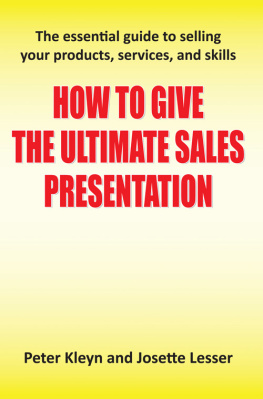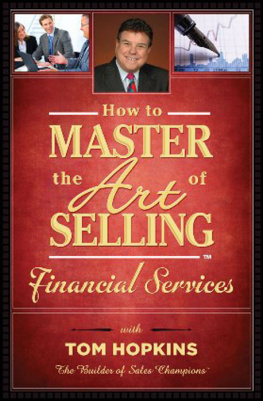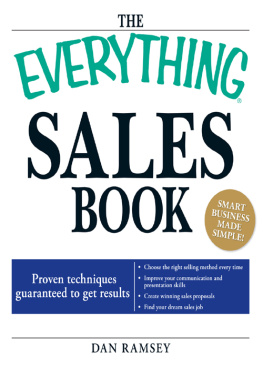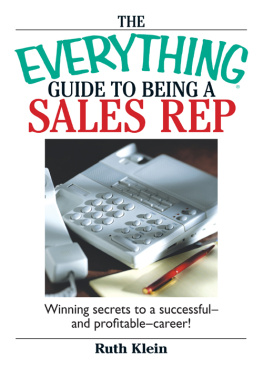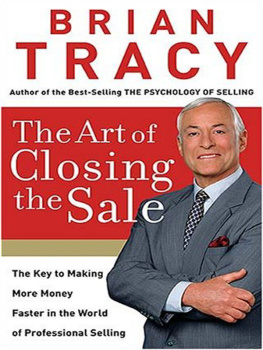
Contents
Researching who and what youre up against
Who to invite to your presentation
The key players
Clarifying your goals
International presentations
Appropriate presentation lengths
How to shape your presentation
Preparing your visuals
Preparing for a demonstration
Gathering evidence for your services and skills
Preparing for Q&A sessions
Practising to get the best results
The effects of the language we use
How to build a rapport with words
The 3 Cs of communication
The power of rhetorical questions
Choosing the right thing to wear
How to present with confidence
Ways to engage and influence your audience
Using written prompts in a presentation
Making the most of visual aids
Demonstrating your products
Showing off your services and skills
Turning questions to your advantage
Dealing with objections and difficult questions
How to progress your sale
The best ways to close a sale there and then
Acknowledgements
This book is very personal to us in both its layout and style. It is based upon our workshops, which have been very successful. We continue to run these for both large corporations and as external workshops for SMEs and individual entrepreneurs, both in Britain and abroad. We would like to thank all of those who have taken the time and trouble to provide us with such wonderful feedback. Many of these testimonials can be found on our website:
www.ultimatesalespresentation.com
We have enjoyed working with each and every one of you.
Of course, we could not have written this book without the wonderful work of many other authors and their insightful research. Please do look at our bibliography for further reading ideas.
And then there are those who have supported us throughout the process of writing this book. We would, therefore, like to thank Sally Kleyn, Martin Le Comte, Richard Wyeth, Edwina Hughes, and The Institute of Sales and Marketing Management.
Introduction
There is no doubt that selling, whether directly or indirectly, is a skill. You may be working as a salesperson selling products to individual customers, small companies, or even multinationals, or you could be selling a service or skill that may have nothing visible to demonstrate.
Or perhaps you are an entrepreneur with a new idea, a new product or a new service. However good the idea, you will still need to sell it.
On the other hand, you may not be formally selling at all perhaps it is you, your skills or your knowledge that are your product? For example, you may work as an accountant, a copywriter, a dentist, a designer, a hairdresser, an IT specialist, a psychologist, a solicitor, a veterinarian the list is endless and you may indeed be freelance.
No matter what or how you are selling, there are times when you will need to sell yourself or your product, by delivering a presentation to one or more people and however you dress it up, it is most likely going to be an integral part of your sales process. So integral that you could win or lose a sale or a contract based on this part of the process alone. Every presentation to a potential customer or client is, in fact, a sales presentation.
At this point, it is also important that we mention another form of sales presentation, and that is the presentation given during a bidding process. Bidding is becoming more and more common when selling your goods and services to larger organisations, particularly to the public sector. This begins with putting in a written tender, which is used to draw up a shortlist of potential suppliers. If you are selected, there is a good chance that you may then be asked to present a bid defence in laymans terms, a sales presentation.
Everything we cover in this book, from the suggestions and recommendations on delivery to answering questions and closing, are as relevant in the bidding process as they are in any normal sales presentation. And, as in all presentations, we have to emphasise the importance of getting your planning and preparation right.
But what are the best ways of ensuring a successful sales presentation? What are the components that allow you to excel at this stage? How can you best engage your audience? What should you be saying and doing for greatest impact? How do you demonstrate your product to best effect? If you have nothing to physically demonstrate, what evidence can you provide to show the credibility of your service? What can you do to move your sale forward? Can you close a sale at the end of your presentation? What is the most effective way to achieve that sale?
This book will not only answer these questions and many others, it will also provide you with a set of skills that can be utilised in many different aspects of your working life.
The book is set out in what we would perceive to be the order that you yourself would construct and deliver your sales presentation. We start with the actual planning involved and finish with your presentation close, before we hand over to you to work your newfound magic!
What follows is a mixture of tried and tested examples and styles, along with some of the latest research and techniques, and our own professional experiences and learning all of which can help you to sell your products, services or skills. We have also tried to lighten the delivery of the information. Certainly we have had fun writing this book, and we make no apologies for the quips and asides contained herein.
You will also find worksheets at the end of this book. We recommend that you complete these as you go along and then refer to them before conducting your sales presentation. We also suggest that you revisit your answers once you have actually carried out your presentation. Would you answer them differently? Would you tweak or add any information?
C HAPTER 1
Planning your Pitch and your Presentation
Researching who and what youre up against
Planning for a successful presentation is as important as the presentation itself and key to this is knowing the audience you will be facing.
Unfortunately, it is a fact of business life that many of the sales presentations you give will be to a pre-selected audience. You may, for example, be asked by a company to deliver your pitch to specific representatives.
This is particularly true in a bidding process, where you may well be up against three or four other prospective suppliers. In this situation, you will most likely be presenting to representatives of the purchasing organisation.
Where you have no influence over who is attending, it is vital to ask the buyers who they have selected to be present. A lot of people feel that they cant ask this, but you will be pleasantly surprised to know that they will usually be quite forthcoming about this. We will talk more about the types of people who might attend later on, but the answer you are given is a clue to how hard you can push for a close at the end of your presentation.
It is also important to establish on what basis the decision to buy will be made. Examples of this include price, ability to deliver to an agreed timescale, or the necessity to meet a technical requirement. This might be hard to come by, particularly when dealing with the public sector - sometimes buyers will be happy to tell you and sometimes they wont. If you can find out these factors, it goes without saying that they should be highlighted in your presentation and in your close. The fact that you are showing this knowledge also holds great sway with the buyers.
Next page
